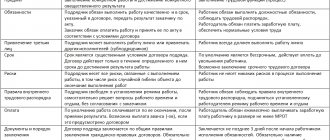Software license agreement (sample)
This type of contract is drawn up taking into account the following points:
- item;
- rights and obligations of counterparties;
- procedure for remuneration and transfer of rights;
- Additional requirements;
- names and brands of the item;
- procedure for resolving disputes;
- deadlines;
- terms of termination;
- details of counterparties;
- signatures.
The essential terms of a software license agreement are listed in Article 1235 of the Civil Code of the Russian Federation. They are:
- The subject of the transaction, that is, the name of the product, the rights to which are transferred.
- List of permitted uses.
- Indication of the amount of remuneration for using the program or the procedure for its calculation. If the transaction is supposed to be free of charge, this must be expressly stated in the contract.
It is important to remember that the signed contract must also indicate the territory in which the user has the opportunity to work with the product. Thus, when drawing up a license agreement with a non-resident for the transfer of software, it is advisable to indicate the country where work with the product is permitted (more details about the definition of the concepts “resident” and “non-resident” are described in our separate article).
As an example, you can familiarize yourself with a sample software license agreement (drawn up in a simplified form) available on our website.
According to Article 1235 of the Civil Code of the Russian Federation, the parties have the right to specify any period of use of the program within the scope of the exclusive right to it of its owner.
If the parties do not specify a term in the agreement, its validity period is 5 years. If the software owner's exclusive rights to it expire before the deal expires, the contract is subject to termination.
It should also be remembered that the owner’s exclusive rights can be transferred to another person due to sale or for other reasons. In this case, license agreements with users are not terminated, but are valid under the same conditions until their expiration. Upon expiration of the contract, the user will need to renew it with the new owner of the rights to the software.
As you can see, the procedure for concluding licensing agreements, as well as the relationship between the software owner and the user, is regulated in detail by the norms of the Civil Code of the Russian Federation. The example of a document given in the article will help you quickly understand all its details and create your own version, if necessary.
- Receiving additional profit from the use of a computer program or database by other persons
Prevention of unfair competition
When concluding a license agreement, the author of a program or database independently provides the rights to use the computer program or database on terms favorable to him, thereby preventing the illegal use of his development
- Drawing up a license agreement for a computer program, database
Documents and information required to receive the service:
- Certificate of state registration of a computer program or database (if available)
- Information about the parties to the agreement
- Essential terms of the agreement
A license agreement for a computer program or database is an agreement between a person who has exclusive rights to a program, a database and third parties who wish to use such a computer program or database for their own purposes.
Third parties have the right to use the program/database only within the framework established by the agreement. Failure to comply with the terms of the agreement by both the owner of the program and the user leads to the application of appropriate sanctions for the party that violated the terms of the agreement.
Licensor is a person who has exclusive rights to a computer program or database (copyright holder).
Licensee is a person who receives, under a contract, the right to limited use of a computer program or database.
License to use computer programs: essence, types
Software license agreement: procedure for conclusion, conditions
Duration of the software license agreement
In accordance with paragraph 1 of Art. 1286 of the Civil Code of the Russian Federation, a license agreement is an agreement on granting rights to use a work (in this case, a computer program) to a person who is not its author or other copyright holder by virtue of the law.
A software license, depending on the scope of the licensor’s rights, can be of 2 types:
- simple (non-exclusive), presupposing that the copyright holder retains the right to issue similar licenses to other persons;
- exclusive, depriving the licensor of such right.
In this case, the formula “1 agreement = 1 type of license” is not mandatory. By virtue of clause 3 of Art. 1236 of the Civil Code of the Russian Federation, within the framework of 1 agreement, a combination of conditions of both types is allowed in relation to different ways of using the software.
The contract requires compliance with a simple written form without additional procedures, such as notarization or state registration. The exception is when it comes to transferring a license for a computer program registered with Rospatent. The license for such software is also subject to mandatory registration.
We invite you to familiarize yourself with: Sample contract for welding work
For simple (non-exclusive) licenses, a simplified procedure for concluding an agreement is acceptable. As such, in particular, the statement of the terms of the agreement on the copy of the program itself, the packaging of such a copy, or in electronic form is regarded (paragraph 2, clause 5, article 1286 of the Civil Code of the Russian Federation).
The position of the courts on this matter is quite clear: the beginning of using the program in accordance with the terms of the agreement set out on a copy of the program or attached to it in the form of an electronic document means the licensee’s consent to enter into an agreement (for example, the resolution of the 1st Arbitration Court of Appeal dated 08/03/2015 No. 01AP-3956/15).
A software license agreement will not be considered concluded if it does not contain clauses regulating:
- licensed object (software, software, etc.);
- permitted uses of the software.
In addition, compensation contracts require regulation of remuneration - the procedure for determining and paying it. If the contract does not contain the appropriate conditions, it will also be considered not concluded (Part 2, Clause 5, Article 1235 of the Civil Code of the Russian Federation).
Important! Particular attention in this part should be paid to agreements concluded in a simplified manner. By virtue of Part 3, Clause 5, Art. 1286 of the Civil Code of the Russian Federation, if such an agreement does not contain a clause on fees, it is a priori considered gratuitous (provided that the agreement itself does not provide otherwise). This condition cannot be changed later.
Another important condition of the license agreement, including for software, is the geography of use of the license. The agreement cannot extend beyond the territory of protection of the software as an object of intellectual property.
In other words, a license agreement must be concluded in order to use the license on the territory of the Russian Federation. Changing geography is allowed only in the direction of narrowing, for example, by selecting 1 or several regions of the country. As for the legal protection of Russian software abroad, it is carried out in accordance with international treaties of the Russian Federation in the field of protection of copyright objects.
If the agreement does not contain a clause regulating the territory of use of the software license, the entire Russian Federation is automatically recognized as such (clause 3 of Article 1235 of the Civil Code of the Russian Federation).
According to the general rule set out in paragraph 4 of Art. 1235 of the Civil Code of the Russian Federation, the validity period of the license is limited by the validity period of the right to the software. Thus, the granting of a perpetual license, although it does not entail the invalidity of the contract, is incorrect.
If there is no clause regulating the period for granting the right to use the software in the contract, the contract is considered concluded for 5 years (Part 2, Clause 4, Article 1235 of the Civil Code of the Russian Federation), provided that the licensor’s exclusive right to the program does not terminate earlier, since In such a situation, the validity of the contract is simultaneously terminated.
Due to its specific nature, drawing up a software license agreement requires not only strict adherence to the Civil Code norms, but also the presence of certain practical skills. Otherwise, there is a high probability of missing many nuances, the significance of which may become apparent already during the validity period of the license. To avoid such consequences, it is recommended to use a ready-made contract form.
Civil contracts in the IT field: ways to acquire rights to software. Part 1
OEM (Original Equipment Manufacturer) versions are pre-installed on computers or other hardware. This type of licensed software is cheaper than boxed versions. Typically, the user is not provided with distribution media, such as when purchasing a new computer with an already installed operating system. But sometimes the OEM version looks the same as the boxed version: a distribution disc, a certificate of authenticity, a license agreement and other necessary documentation. In any case, the OEM product can only be used on the hardware with which it was supplied.
3. OLP version
Corporate delivery option when more than five software packages are required. Suitable for both individual entrepreneurs with a small staff and large organizations. OLP licenses are issued to a specific legal entity. This is a license key that is distributed to a certain number of workstations. Definitely, this type of agreement with the copyright holder is more profitable than buying boxed packages.
How can you determine if the software you are purchasing is genuine?
The main sign of software legality is the presence of a Certificate of Authenticity (COA). In the Box version, you should pay attention to the mark located on the side of the box in the form of a holographic sticker. For the OEM version, such a label is placed on the computer case or provided as a separate document.
But the COA only talks about the authenticity of the program. The main legal document is the license agreement, which defines the obligations and restrictions, the procedure and conditions for working with the software. It is provided as a standalone document for boxed versions and in some OEM versions. It may also be printed in operator manuals. Very often, the license agreement is included in the distribution itself. So, when installing the software, you must accept its terms. If you do not agree to these terms, you may not install the software. By installing the program on your computer, you automatically accept the terms of the license agreement, even if you have not read it. Therefore, it is recommended to carefully review such documents.
If you do not agree to the terms of the agreement for the pre-installed software, you should erase it from your computer and return the product and packaging.
Can I use the software without client licenses?
A client license is not required for the operation of network equipment and the entire local network. But to comply with the law and in accordance with the licensing agreement, they must be used in the workplace. Controlling persons, as a rule, have sufficient qualifications and carefully check this.
What should budgetary government institutions do if they simply cannot afford to purchase licensed software?
Organizations such as higher educational institutions, colleges, schools, schools, technical schools and others that have licenses to carry out educational activities on behalf of the Ministry of Education of the Russian Federation, as well as healthcare institutions accredited in the territory of the Russian Federation by the Ministry of Health, have the opportunity to purchase information licensed products from the company Microsoft at a special rate marked AE (Academic Edition).
If a government agency is included in the unified register of budgetary organizations, it also has the opportunity to purchase licensed software at a significant discount. Such software is labeled as GOVT.
Does the user have the right to make copies of software products on digital media?
The license agreements strictly state that copying the software is prohibited and illegal.
What to do with this type of information products such as dictionaries, encyclopedias, interactive materials, etc., which require working directly from a licensed disk? Is it possible to create a working copy of the software on another storage medium?
No, you shouldn't do this. Per the license agreement, you may only retain the original software discs. If the program requires an information source, you can create an additional copy of it, but only as a backup or archive, and not a working one.
Of course, the license agreement may stipulate otherwise, but as a rule, copies of the software and accompanying documentation cannot be made.
And if a disk with licensed software is damaged during operation, does the user have the right to receive a duplicate of it for free?
Unfortunately no. The user has the right to receive another original media only in the event of an industrial defect. To do this, you need to log in, make a request to technical support and wait for the results of the examination with a decision on issuing a duplicate.
Is it possible for the legal owner of the software to transfer or sell the rights to use the program to another person? What needs to be done for this and what documents need to be submitted for re-registration?
The user of the Box version has the right to transfer his rights to use the software once in accordance with the license agreement. To complete the transfer, you must provide all components of the software: distribution kits, operator manuals and other printed documents, license agreement and certificate of authenticity, if available. Such transfer is not permitted through third parties, only directly. The entity receiving the software for official use must agree to the terms of the license agreement, including the condition not to transfer the right to use it to anyone else.
The OEM version of the program is transferred at the time of sale or donation of the hardware on which it was installed.
If we are talking about transferring OLP licenses, you must contact the company from which you purchased the software, or directly the distributor.
What to do if the performance of hardware does not allow installing modern Windows operating systems (OS)? Is it possible to buy a license for an old version of the OS when they are no longer produced?
Yes, this is possible according to the existing downgrade rule. If the user has a license for a program, it also applies to lower versions of this software. In this case, there is no need to purchase the software media of the younger version, since we are talking only about the right to use.
Let's assume a user has purchased a license for Windows XP Pro. In this case, he has the right to use operating systems of previous versions up to Windows 95.
Who controls the legality of the software used, and what documents should the controlling persons have?
As a rule, such inspections are carried out under the jurisdiction of the tax inspectorate or the department for combating economic crimes. Controllers must present official identification confirming their membership in the above-mentioned bodies, as well as a prosecutor’s resolution authorizing the inspection.
What documents should the user have in case of verification?
The user of the original software must have the following documents:
— for the Box version – packaging and registration card. Registration using this card is necessary to receive technical support in states that were formerly part of the USSR. Users in other countries can register via the Internet;
- for the OEM version - special markings on the body of the technical device;
— for the OLP version – a license issued in the name of the organization (in the form of a security with a holographic sticker).
For additional insurance, it is better to save all payment documents for the purchase of software (invoices, checks, etc.).
Which official is responsible for non-original software installed on the organization’s technical equipment? Specific user, technical employee or manager?
Responsibility lies with the main manager of the organization (director, manager, boss, etc.), since the installation of software on employee workstations officially occurs with his permission and must be under his direct control.
Do regulatory authorities have the right to inspect home computers to determine the legality of software use?
Yes, they do. Using hacked software is actually a crime against intellectual property. This is punishable by law. Moreover, there have already been such precedents in Moscow. But if such an inspection suddenly comes to you, you need to make sure that the controllers have the necessary documents (certificates, official resolutions, search warrants).
Do inspectors have the right to seize technical equipment?
Yes, they do if there are suspicions about the use of hacked software. The computer is seized for examination, which is paid for by the owner. If the examination confirms the presence of unlicensed software, the technical means are transferred to the benefit of the state, and a case is initiated against their owner in accordance with the state Criminal Code regarding violation of copyright and related rights. Such a crime allows for a sentence of imprisonment.
If the examination does not confirm the presence of unlicensed software, who will pay for the storage of technical equipment and their examination?
The direct user will still pay. But he also retains the right to file a counterclaim against the authorities that seized the computer, with the wording of a violation of the functionality of the organization.
Where can you go to establish the legality of using software without fear of being caught in violation?
The user must contact an intermediary company that sells licensed software.
Call me back within 10 minutes!
A license agreement is an agreement in which the owner of the rights to a trademark (licensor) grants another party (the licensee) the right to use its intellectual property under certain conditions.
Non-exclusive rights
When signing a non-exclusive or simple license, the licensor can sign similar contracts for the use of the specified object with other persons.
In case of delay in payment for the received software, the Licensor has the right to stop providing the Licensee with consulting assistance on the software necessary for operation, provided for in clause 3.2.3, clause 3.2.4 of this agreement. 7.4.
The parties are not responsible for complete or partial failure to fulfill obligations under this agreement if the failure to fulfill obligations occurred as a result of force majeure: natural phenomena such as flood, earthquake, fire; epidemic, as well as as a result of military actions, strikes, mass riots, significant changes in legislation that impede the execution of the contract, as well as other actions and events beyond the will of the parties, which, acting prudently, the parties did not foresee and could not foresee (force- major). 7.5.
9.2 The Agreement, all amendments and additions to the Agreement, transmitted by fax or electronic communication and signed by authorized persons, have legal force, with subsequent dispatch of the originals of the Agreement, amendments and additions by mail within 3 business days. 10.
It is important that computers with consulting services, on the one hand, and in the person acting on the basis, hereinafter referred to as the “Licensor”, on the other hand, hereinafter referred to as the “Parties”, have entered into this agreement, hereinafter referred to as the “Agreement”, on the following: 1.
BASIC CONCEPTS APPLIED IN THIS AGREEMENT 1.1.
Licensor is the author (developer) or other holder of the exclusive right to computer programs who has the authority to transfer the rights to use the program under a license agreement on the basis of copyright certificates, patents, certificates and other title documents. 1.2. Licensee is a person who is granted the right to use a computer program by the author (developer) or other holder of the exclusive right to a computer program under the conditions stipulated by the license agreement.
Sample act for transfer of rights to software
At the beginning of the document it is written:
- name of the document and its number;
- date of drawing up the act;
- information about the organization transferring the software and the company receiving it (their names, positions and full names of managers are entered here);
- the agreement on the basis of which this action is carried out (indicating the number and date of its conclusion).
The plate below provides identification information about the transferred software (name, type, quantity, cost, etc.). The more detailed the data is indicated here, the better; it is even permissible to duplicate in the act some aspects of the agreement to which it is an annex.
It should be noted that the software was transferred in proper quality and in full. If the object of reception and transfer does not have a material expression (which is quite acceptable under the current law), then the form records only the transfer of rights to use it.
NOTE! The act is signed by both parties.
How to draw up a license agreement
The article talks about the procedure for concluding a license agreement, in particular, a software license agreement. The article also gives an idea of the validity period of such agreements.
We suggest you read: Registration of an employee under a contract
To use intellectual property in your work, you must draw up a special agreement. When concluding licensing agreements, special rules of execution, terms of the agreement and typical conditions apply. Obtaining a software license requires a special procedure.
A license agreement is a special agreement that sets out the conditions under which a person who has rights to intellectual property gives another person the opportunity to use his results in his work. On this basis, both parties have mutual obligations.
As a rule, the owner of intellectual property grants the opposing party the right to use it for a fee or fulfill other obligations.
The owner of the intellectual property is called the licensor. The person who, according to the contract, will use the results of intellectual work is called a licensee.
The conclusion of such contracts is regulated by the Civil Code. They are concluded according to the rules established in Chapter 9. Thus, they are treated as trade, but have a number of significant differences:
- the subject of such transactions are intangible values;
- after the conclusion of the contract, the right of dual ownership is established, that is, the licensor retains the right to use the product of intellectual work in his work;
- the licensee has the right to transfer intellectual property to a third party if this is provided for by the terms of the agreement.
The main purpose of drawing up such contracts is to provide special conditions under which the intellectual property that is their subject will be used.
The license agreement includes the following essential terms:
- item;
- territorial area in which the contract is valid;
- validity;
- the nature and amount of payment for the granted right to use intellectual property;
- procedure for making payments.
The combination of all of the above terms constitutes the entire license agreement.
Item
The licensee is granted permission to use the results of the work listed above. The use of such values requires a certain method, which is also specified in the contract. For example, this could be shown on video.
Territory
The contract specifically indicates the territory in which the licensor allows the licensee to use the results of his intellectual work. In some cases, the list of territories is drawn up as an appendix.
If the territory is not mentioned, then, according to the law, the item is used within the Russian Federation.
Validity
A separate clause in the contract specifies the validity period. If this data is not indicated, then special rules provided for by law come into play.
Remuneration for the right to use the results of intellectual work is prescribed in a special clause. Remuneration refers to the following forms of payment:
- royalties, that is, periodic payments, the amount of which is set as a percentage, for example, of sales;
- lump sum payment, that is, a certain amount that is paid immediately or in installments, depending on the conditions.
When paying in the form of royalties, the licensor receives up to 30% of the income generated by the sale of his work.
The contract specifies a certain result of intellectual work, for example:
- piece of art;
- treatise;
- brand names or logos;
- invention;
- computer database;
- computer software.
As a rule, when making such transactions, the essential point is the registration of the intellectual property object. The fact of registration is confirmed by copies of certificates that are attached to the contract, and their numbers are indicated in the contract.
Conclusion procedure
The conclusion of the agreement in question presupposes a certain procedure and validity period.
The procedure involves going through several stages.
- Collection of necessary documents. At this stage, certificates of registration of the intellectual property object are issued and copies are prepared.
- Drawing up a draft agreement. At this stage, all the conditions proposed by the parties are written down.
- Conduct of negotiations. The terms are discussed by the parties, and adjustments are made if necessary.
- Signing.
- Submitting an application for registration of a contract. This stage involves registration with Rospatent. To do this, the parties draw up an application and submit it along with copies of all necessary papers.
Registration is one of the essential conditions for the validity of such contracts. The registration procedure takes up to 3 months.
To carry out the registration procedure, the following documents are required:
- a statement drawn up in free form;
- receipt of payment of state duty;
- 3 copies of the contract;
- a power of attorney provided if documents are submitted by representatives of the parties.
Rospatent has the right to refuse registration, for example, if not all necessary documents are provided. In this case, the decision to refuse is sent to the applicants in writing, indicating the reasons for the refusal.
We suggest you read: Question about prenuptial agreement and mortgage
Validity
According to the law, the duration of the agreement is determined by the consent of the counterparties. If the agreement does not provide for this clause, then the licensor may terminate it five years after its signing.
The only condition is to inform the licensee in writing of your decision.
If the contract states that its validity is unlimited, then it is valid for the entire term of copyright. It constitutes the life of the author and the next 50 years after his death.
Software is a product of intellectual work. The right to use this product in some cases is issued in the form of an exclusive license.
According to the Civil Code, the licensor is prohibited from transferring the rights to the item to other persons. The licensee, in turn, undertakes to report to the counterparty on its application.
Features of the formation of the act, general information
Before describing this specific act in detail, we will give general information that applies to all such forms.
- Firstly, if an enterprise has a sample document established in its local regulatory policy, the act must be drawn up according to its type. But if such a sample is not available, no problem - the act can be formed in a free form, from the point of view of the law, such an approach is not a violation.
- Secondly, the act can be written manually or done electronically. Moreover, if the second option is used, the document must be printed after creation - this is necessary so that those responsible for the acceptance and transfer of the software can endorse the act with their signatures. If it is customary for an organization to use seals to certify papers, the act must also be stamped.
- Thirdly, the document should be made in at least two identical copies
(if the act is written by hand, it is convenient to do it using carbon paper) - one for each of the parties whose representatives are involved in drawing up the form. If necessary, the act can be duplicated, also having all copies properly certified. - Information about the act should be registered in a special accounting journal, which, as a rule, is kept by the secretary of the enterprise or other responsible employee.
Concept and features
A license agreement is a special agreement that sets out the conditions under which a person who has rights to intellectual property gives another person the opportunity to use his results in his work. On this basis, both parties have mutual obligations.
The owner of intellectual property is called the licensor. The person who, according to the contract, will use the results of intellectual work is called a licensee.
The conclusion of such contracts is regulated by the Civil Code. They are concluded according to the rules established in Chapter 9. Thus, they are treated as trading, but have a number of significant differences:
- the subject of such transactions are intangible values;
- after the conclusion of the contract, the right of dual ownership is established, that is, the licensor retains the right to use the product of intellectual work in his work;
- the licensee has the right to transfer it to a third party if this is provided for by the terms of the agreement.
Item
The licensee is granted permission to use the results of the work listed above. The use of such values requires a certain method, which is also specified in the contract. For example, this could be shown on video.
Territory
The contract specifically indicates the territory in which the licensor allows the licensee to use the results of his intellectual work. In some cases, the list of territories is drawn up as an appendix.
If the territory is not mentioned, then, according to the law, the item is used within the Russian Federation.
Validity
The validity period is specified in a separate clause in the contract. If this data is not indicated, then special rules provided for by law come into play.
Pay
Remuneration for the right to use the results of intellectual work is prescribed in a special clause. Remuneration refers to the following forms of payment:
- royalties, that is, periodic payments, the amount of which is set as a percentage, for example, of sales;
- lump sum payment, that is, a certain amount that is paid immediately or in installments, depending on the conditions.
When paying in the form of royalties, the licensor receives up to 30% of the income generated by the sale of his work.
As a rule, when making such transactions, an essential point is the presence of registration of an object of intellectual property. The fact of registration is confirmed by copies of certificates that are attached to the contract, and their numbers are indicated in the contract.
Sublicense agreement
The Civil Code allows the execution of so-called sublicensing contracts when transferring the right to use software. The licensee can transfer the rights to use the licensor's intellectual property to other persons.
To conclude such a transaction, the written consent of the copyright holder is required, which is drawn up separately or stated in the agreement itself. The sublicense agreement is drawn up for the same period as the corresponding license agreement.
It is compiled according to the following points:
- item;
- rights and obligations of counterparties;
- special conditions;
- deadlines;
- other conditions;
- details of counterparties;
- signatures.
Tags: contract, license, sample, provision, program








